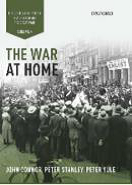Volume 4 of The Centenary History of Australia and the Great War series. This is the second last work in The Centenary series. The very-highly credentialed and well-published trio of Yule, Connor and Stanley have each written Parts on Economy, Politics and Society respectively. The Parts are approximately equal in length and contain between eight and ten chapters − most being broken into a number of sections. Their detail and depth of coverage is quite exceptional.
In 1914 Australia was enjoying expansion in the production of wool and wheat, growth in the mining and manufacturing areas, and experiencing an upsurge in urban infrastructure development and housing construction. With the declaration of war came the uncertainty of export industries being able to get their production to market. The solution to these problems was not immediate and evolved over the duration of the conflict.
The Australian military forces were totally clothed in locally produced items, while many patriotically-motivated companies tried, without success, to produce artillery shells. War bonds were successfully introduced to help finance the war. Disenchantment with abuse of government powers, two conscription campaign and ‘war weariness’ resulted in a five-week ‘great strike’ in August 1917 – the total days lost for the year were triple those of 1916.
War was declared when Australia was in the middle of an election campaign. The Liberal Prime Minister, Joseph Cook lost the September election to Andrew Fisher’s Labor Party. Fisher’s Attorney General, Billy Hughes, became Prime Minister at the end of October 1915. Hughes went to Britain in 1916 to place Australia’s views on settlement of the war, finding merchant ships to carry Australian exports, and markets for base metals and a bumper wheat crop.
The novelty of the ‘great adventure’ gone with the reported huge losses on the Western Front saw Hughes unsuccessfully take Australia to two referenda asking for conscription in both 1916 and 1917 in endeavours to reinforce the depleted Australian Military Forces. 1916 saw a split in the Labor Party, with Hughes forming a National Labor Party and retaining his prime ministership through a coalition with the Liberals, forming a Nationalist government that was re-elected in December 1919.
A generally positive outlook by Australians greeted the declaration of war. There were volunteers in droves. Then the reality of casualties, stringent government regulations and censorship, and internment of Germans in ‘concentration’ camps became realities in Australian society. The lot of women became one of ‘working, waiting and hoping’. The male society was becoming polarized into those who had enlisted and those who were not prepared to do so. Prior to the outbreak of war, the great majority of Australians were adherents to some Christian religion, but due to the clergy delivering news of fatalities and, with the exception of the Catholic Church, being strong advocates for conscription, a 20 percent drop occurred in this level by war’s end. Strict government censorship had controlled what the public knew of the war, and subjected them to ‘appropriate’ propaganda. Although Australia was never invaded, it lost 60,000 servicemen, and other ‘inconveniences of war’ included erosion of civil and political liberties, the persecution and vilification of large minorities who came to be regarded as enemies: German and Irish Australians and trade unionists.
Those who returned did not return to the country they went to fight for, and those who stayed at home were employed when they were not. In 1919 there were over 12,000 Australian deaths due to Spanish flu. Well-intentioned Soldier settlement schemes often failed because of the marginality of their concept.
This volume does a great deal to complement existing writings on The Great War. It has been thoroughly researched, is well-written and easy to read, and contains high quality photographs, a (composite) bibliographic essay and comprehensive index. Volume 4 is an excellent work for those wishing to broaden their knowledge of Australia society during this period.
Reviewed for RUSI by Neville Taylor, March 2016

Hardback RRP: $59.95
Contact Royal United Services Institute about this article.






